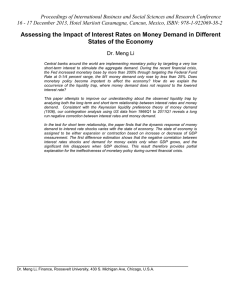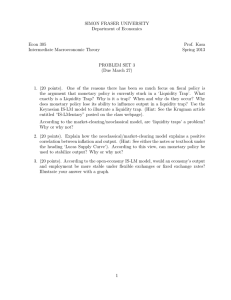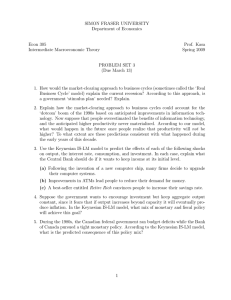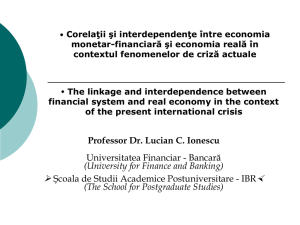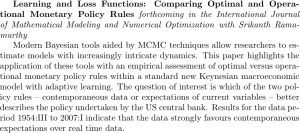Saez’s Discussion of Michaillat and “An Economical Business-Cycle Model” Eric T. Swanson
advertisement
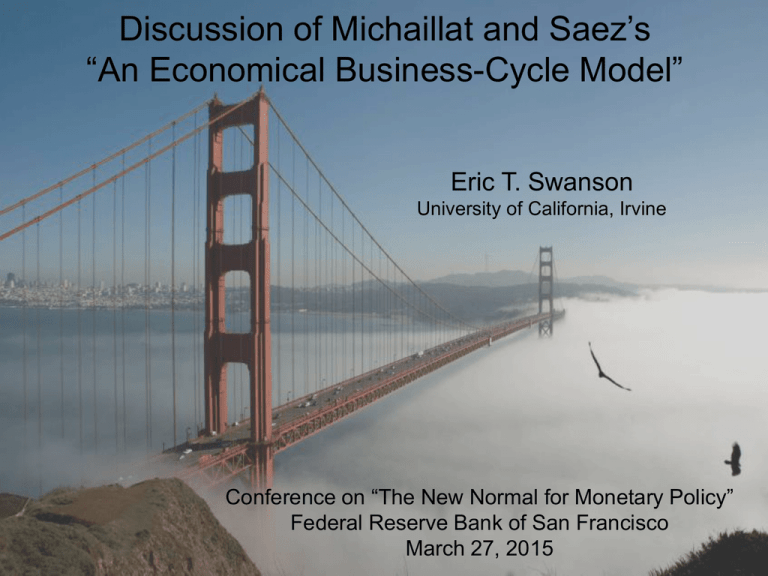
Discussion of Michaillat and Saez’s “An Economical Business-Cycle Model” Eric T. Swanson University of California, Irvine Conference on “The New Normal for Monetary Policy” Federal Reserve Bank of San Francisco March 27, 2015 Motivation The standard New Keynesian model does not match two very important features of recent global experience: • Inflation has hardly fallen (despite lots of slack) • Liquidity traps have been extremely long-lived/persistent Previous work by Michaillat and Saez (2013 NBERWP) develops an alternative model based on matching frictions in product and labor markets (generalization of Barro-Grossman) The present paper modifies/extends that model to have: • an interest rate • potential for a liquidity trap • a Phillips curve (in extra extension of the model) Contributions • Provides alternative to New Keynesian model • Extends/pushes frontier of the Michaillat-Saez (2013) model • Provides microfoundations for IS-LM model, based on matching frictions • Model is very simple (static), can “inspect the mechanism” • Can model permanent liquidity traps, fixed inflation Is the U.S. in a Permanent Liquidity Trap? Or just recovering from a big shock? source: Bureau of Labor Statistics, Federal Reserve Economic Data (FRED) Is the U.S. in a Permanent Liquidity Trap? The FOMC forecasts that the federal funds rate will rise substantially: source: FOMC Survey of Economic Projections, March 18, 2015 Is Japan in a Permanent Liquidity Trap? Japanese GDP growth has been sluggish, but recall: source: OECD, Federal Reserve Economic Data (FRED) Is Japan in a Permanent Liquidity Trap? Japanese GDP growth per working age person averaged 2.4% from 2002-07 8.0 6.0 4.0 2.0 0.0 -2.0 U.S. dot-com bust East Asian Crisis -4.0 -6.0 -8.0 Global Financial Crisis -10.0 source: OECD, Federal Reserve Economic Data (FRED), author’s calculations Is Japan in a Permanent Liquidity Trap? The BIS makes the same point: Japan grew more rapidly than the U.S. in both the 2000s and 2010s: source: Bank for International Settlements Quarterly Review, March 2015 Is Japan in a Permanent Liquidity Trap? Japanese monetary policy was lifting off in 2007, before the GFC hit: source: International Monetary Fund, Federal Reserve Economic Data (FRED) Do We Need a Model with Fixed Inflation? Or is inflation consistent with a New Keynesian model? Del Negro, Giannoni, and Schorfheide (2015 AEJMacro) show that a New Keynesian model with financial frictions predicts inflation remarkably well: Do We Need a Model with Fixed Inflation? In Del Negro et al. (2015), inflation expectations are well anchored and marginal costs were consistently expected to mean-revert: Do We Need a Model with Fixed Inflation? Swanson and Williams (2014 AER) also find that forecasters consistently thought recovery was imminent throughout 2009-11: Main Motivations Are Questionable • It’s not clear that we need/want a model of permanent liquidity traps. • The behavior of the U.S. and Japan seem consistent with recovery from U.S.: One big shock Japan: Two big shocks • New Keynesian model with a large shock and financial frictions seems to fit recent U.S. experience very well. • According to the NK model, inflation has been sluggish because expectations are well anchored and firms expected marginal costs to mean-revert. Still, this paper provides an alternative to the NK model Other alternatives: Benhabib, Schmitt-Grohe, Uribe (2001 JET, 2002 JPE), Farmer (2010 JME, 2012EJ), Eggertsson-Mehrotra (2014 NBERWP) Barro-Grossman (1971) Labor supply Actual labor demand; displays rationing because additional produced goods cannot be sold Frictionless labor demand Michaillat-Saez (2013) In Barro-Grossman (1971), rationing process is not specified In Michaillat-Saez (2013) • goods and labor are rationed through matching process • supply and demand can be equilibrated either through change in p, or change in market tightness (or both) Model is static—no dynamics Raises questions: • Why don’t prices adjust at all? (Why only matching?) • If a firm lowers its price, shouldn’t its chance of matching improve? This Paper Relative to Michaillat-Saez (2013): • Model has some superficial dynamics (e.g., interest rate) • But model jumps from one steady state to another • Analysis compares steady states (static) • Wealth enters the utility function, to generate IS curve in SS Model here is very similar to IS-LM (with fixed prices!) This means it inherits shortcomings of original IS-LM model: • No dynamics • No tendency to return to natural rates • Monetary policy is conducted through money supply, not the short-term interest rate • What about IS-MP model? Steady-State IS Curve IS curve in the model is not dynamic Household’s Euler equation: 𝑢′ 𝑐𝑡 = 𝛽 1 + 𝑟𝑡+1 𝑢′ 𝑐𝑡+1 + 𝜔′(𝑎𝑡+1 ) In steady state, 𝜔′(𝑎) 1= 𝛽 1+𝑟 + 𝑢′(𝑐) Higher r implies lower c (and higher a), which implies a steady-state “IS curve” Monetary Policy Equilibrium in the model can be achieved either through prices, through market tightness, or both. Michaillat and Saez assume a fixed-inflation equilibrium: the path of prices is exogenous, fixed. Monetary policy = choice of initial real money balances m(0). Central bank cannot choose money growth (by assumption)! If we let central bank choose money growth, then CB can: • choose steady-state inflation • lower steady-state real interest rate • shift out the steady-state IS curve There would be no steady-state liquidity trap. Monetary policy in the model is either crippled, or too powerful. Unconventional Monetary Policy In this paper (and IS-LM), Unconventional Monetary Policy is: • Helicopter drop • Fiscal policy The model is unable to consider: • Forward guidance • Long-term bond purchases Monetary policy in the model is not interesting: • Standard monetary policy is crippled (by assumption) • Unconventional monetary policy is totally uninteresting A main reason why the New Keynesian model has been so successful is because it models monetary policy so well. Summary of Comments 1. Michaillat-Saez (2013) provide a very interesting alternative to standard New Keynesian model 2. This paper extends that framework to generate: A. Permanent liquidity traps B. Fixed inflation 3. Whether we need/want these extensions is questionable 4. Steady-state IS curve is awkward, strange 5. Monetary policy in the model is not interesting 6. Authors should think about monetary policy more seriously. The NK model is an excellent model of monetary policy. 7. Authors should think about dynamics more seriously. Even the textbook IS-LM/AS-AD model has useful dynamics.
